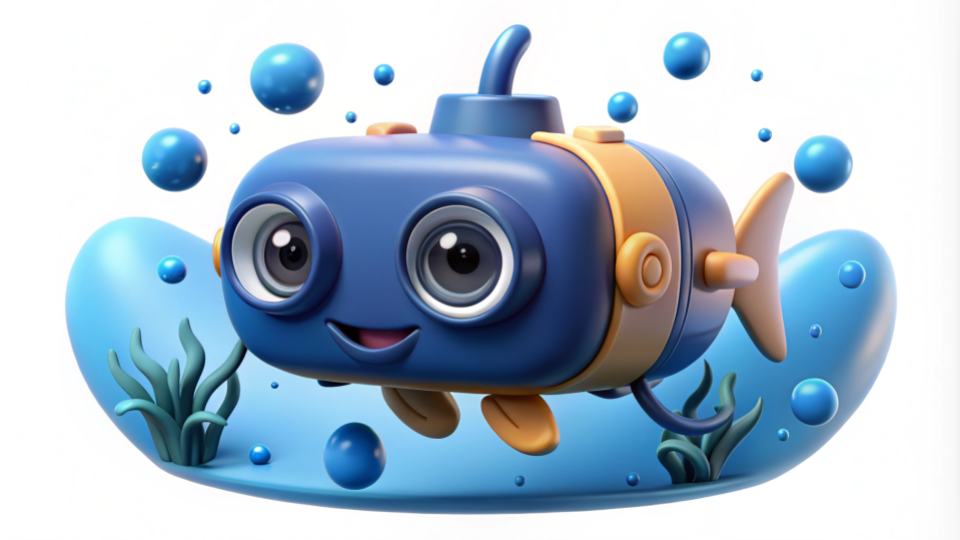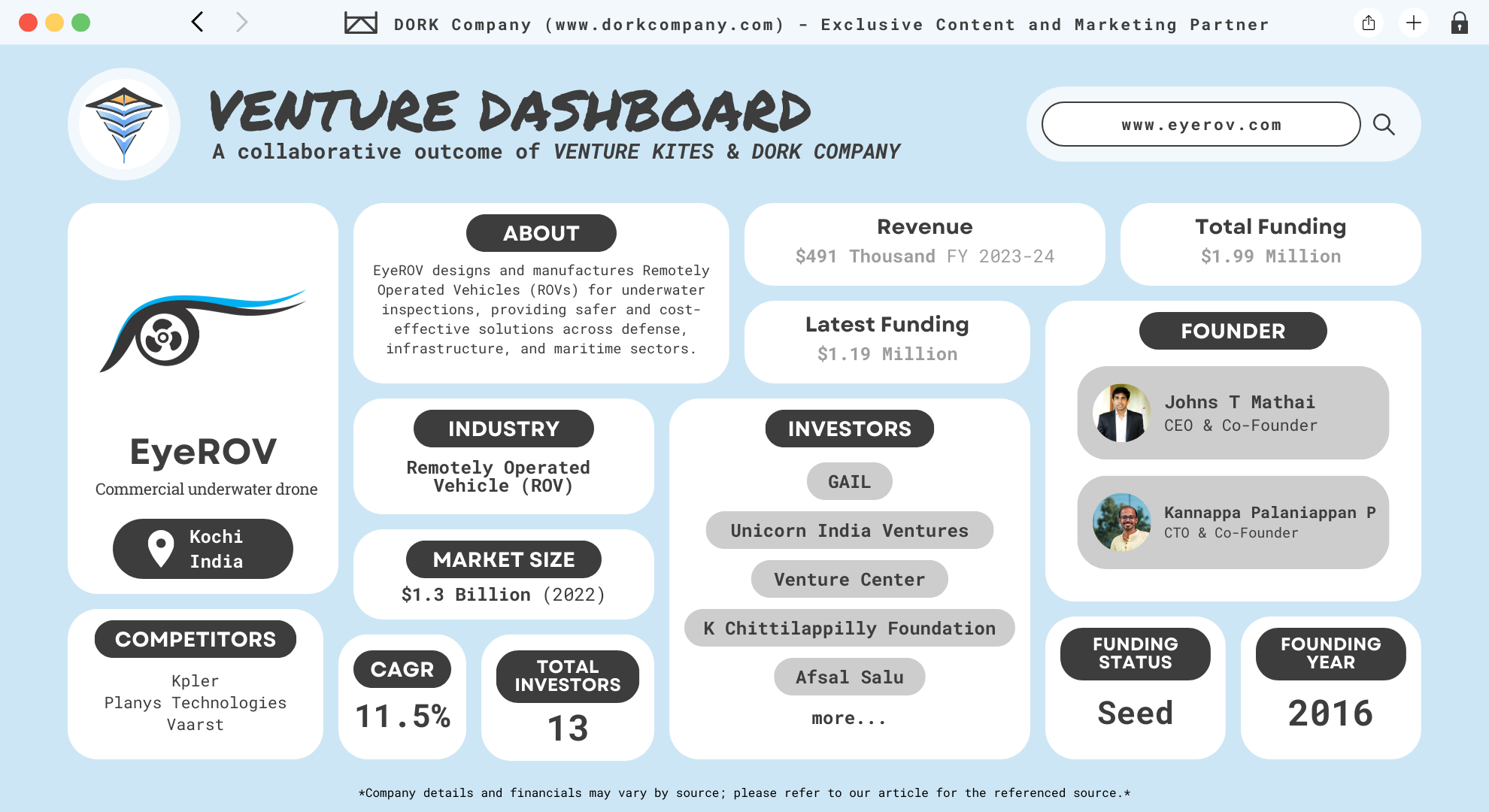EyeROV : How Their Underwater Drones Are Taking Over the Ocean

If you think drones are only for the skies, EyeROV will make you think again! EyeROV is the maker of India’s first commercial Underwater Drone. This innovative startup from Kochi, India, has taken drones to new depths—literally. EyeROV, founded in 2016 by IIT alumni Johns T Mathai and Kannappa Palaniappan, is revolutionizing underwater exploration with its advanced Remotely Operated Vehicles (ROVs). The company creates smart and efficient underwater drones designed for inspection and surveillance. (Eyerov)
EyeROV’s cutting-edge technology solves real-world problems across industries like defense, infrastructure, and maritime. Their drones can perform critical underwater inspections in challenging environments, from inspecting dams and bridges to navigating murky waters to examine pipelines and offshore structures. EyeROV’s mission is to make underwater inspections safer, smarter, and more cost-effective by providing both the hardware and software solutions needed for thorough underwater monitoring.
What sets EyeROV apart is its commitment to high-quality data collection and the integration of artificial intelligence. Their drones don’t just capture video; they use AI-driven analytics to turn underwater footage into actionable insights. Headquartered in the Kerala Technology Innovation Zone, EyeROV’s approach has positioned it as a leader in India’s growing marine robotics sector. By tapping into local resources and fostering partnerships with organizations like the Defense Research and Development Organization (DRDO), the company is making waves in the global ROV market. (Kerala Technology Innovation Zone)
Two Minds, One ROV-lution: The Founders Who Took the Plunge
EyeROV is the brainchild of Johns T Mathai and Kannappa Palaniappan, two IIT alumni who shared a vision for revolutionizing underwater technology. They founded the company in 2016 after realizing the potential for smaller, more efficient underwater drones that could perform the same tasks as the bulky, traditional ROVs used by large industries. Their academic and professional backgrounds set the stage for this ambitious endeavor
Johns T Mathai, the CEO and Director, holds a Master’s in Technology (MTech) in Electrical and Electronics Engineering from IIT Delhi. Before that, he earned a Bachelor of Technology (BTech) in Applied Electronics and Instrumentation from the College of Engineering Trivandrum (CET). His experience spans multiple industries. He worked as a Lead Engineer at Samsung and later as a Firmware Engineer at Grey Orange Robotics, where he honed his skills in robotics and automation. (Johns T Mathai)
Kannappa Palaniappan, the CTO and Director, has a solid foundation in Ocean Engineering. He earned his Master’s Degree from IIT Madras, specializing in Ocean Engineering, after completing his Mechanical Engineering degree at College of Engineering Trivandrum. His hands-on experience as a Project Scientist at the National Institute of Ocean Technology (NIOT) exposed him to the practical challenges of ocean-based technologies. (Kannappa Palaniappan)
The idea for EyeROV took root when Kannappa, working with NIOT, noticed that traditional ROVs used for underwater inspections were too large and cumbersome. He envisioned creating a lighter, smarter ROV that could accomplish the same tasks more efficiently. He discussed this with Johns, and together they built a Minimum Viable Product (MVP). The MVP was a smaller ROV built with simple materials but designed to prove the concept. They showcased their prototype to the Kerala Startup Mission, and by October 2016, EyeROV was incubated.
Sink or Swim: The Booming ROV Market
The Remotely Operated Vehicle (ROV) market is diving deeper, quite literally, with its rapid growth. If you thought ROVs were niche tech, think again! The global ROV market is projected to soar from $1.3 billion in 2022 to $3.8 billion by 2032 at a CAGR of 11.5%, driven by increasing offshore energy projects, deep-sea exploration, and advances in marine research (Global Market Insights Inc.)
Key Growth Drivers
One of the main drivers of this growth is the offshore oil and gas industry. ROVs are essential in inspecting, maintaining, and repairing offshore infrastructure like pipelines and drilling equipment. In fact, the oil and gas sector held a 44.6% market share in 2023, highlighting the dependence on ROVs for operations in extreme environments. Additionally, the rise of renewable energy projects, such as offshore wind farms, is expanding the use of ROVs for tasks like underwater construction and cable laying. (Market.us)
Technological advancements are another major boost for this market. Innovations in sensors, communication systems, and power efficiency are making ROVs more capable and cost-effective, which in turn is driving adoption across various industriess.
Market Segments
The market is segmented by depth and application. Shallow-water ROVs dominate tasks like environmental assessments and coastal infrastructure monitoring. Meanwhile, deepwater ROVs are crucial for challenging deep-sea operations like oil exploration and scientific research. These segments reflect the versatility of ROVs, as they serve industries from scientific research to defense and aquaculture.
With the surge in offshore activities and the push for renewable energy, the ROV market is poised for continued growth. As companies seek efficient and safe solutions for underwater operations, ROVs will remain at the forefront of marine exploration and maintenance.
Making a Splash: EyeROV’s Vision for the Future of Underwater Tech
EyeROV is revolutionizing the underwater robotics industry with its cutting-edge, indigenous technology. The startup’s mission is to build safer, smarter, and efficient solutions for underwater inspection and surveillance, primarily serving sectors like energy, infrastructure, and maritime.
Mission and Vision
EyeROV aims to disrupt traditional underwater inspections by leveraging advanced robotics and AI. Their solutions make underwater work safer and more efficient, replacing costly and risky diver-led inspections with high-tech ROVs. This mission aligns with their broader vision of providing technology-driven solutions that enable better decision-making and improved safety for critical infrastructure. (EyeROV)
Problems They Solve
EyeROV addresses several critical challenges. Traditional underwater inspections are dangerous, expensive, and often inefficient. The startup’s ROVs are designed to operate in harsh environments such as murky waters and tight spaces, allowing for high-quality, real-time inspections without putting human lives at risk. Their products cater to multiple sectors, including oil & gas, defense, shipping, and research. EyeROV’s technology helps streamline tasks like inspecting dams, pipelines, bridges, and even ship hulls, improving safety and efficiency in industries dependent on underwater operations.
Business Model
EyeROV’s business model revolves around selling and leasing underwater ROVs while also providing specialized inspection services. Their flagship product, the EyeROV TUNA, is India’s first commercial underwater drone, designed for critical infrastructure inspections. They also offer a range of customized solutions, enabling clients to tailor the ROV’s capabilities to their specific needs. The company supports its product line with its EyeROV Visualization and Analytics Platform (EVAP), which processes data gathered from underwater operations, offering advanced image enhancement, real-time data analysis, and geotagging.
Reeling in Success: EyeROV’s Product Line That Catches It All
EyeROV isn’t just diving deep into the water—they’re diving into cutting-edge technology too. The company has a powerful portfolio of underwater robotics and inspection solutions designed to tackle complex underwater environments. Let’s break down their main products and services.
Products
- EyeROV TUNA: The flagship product and India’s first commercial underwater drone, EyeROV TUNA is a versatile, lightweight Remotely Operated Vehicle (ROV). With an operational depth of 100 meters, it provides live HD video feeds of submerged environments like dams, bridges, ship hulls, and offshore structures. Weighing just 20 kg, it’s portable and offers a 3+ hour operation time, making it ideal for long inspections. (EyeROV TUNA)
- EyeROV TROUT: This is EyeROV’s military-grade ROV, designed for more demanding underwater tasks. With a depth range of 300 meters and 4K video capabilities, EyeROV TROUT is perfect for defense and research purposes. It also features advanced payload options and autonomous navigation. (EyeROV TROUT)
- EyeROV iBOAT ALPHA: A drone ship developed for bathymetric and hydrographic surveys, iBOAT ALPHA is an unmanned surface vehicle designed for a range of marine research and survey operations. Its modular architecture allows customization based on project needs. (EyeROV iBOAT ALPHA)
- EyeROV NEOPIA UW-50: The NEOPIA UW-50 is a specialized underwater camera used in commercial diving and underwater surveys. This camera is tailored for operations where real-time, high-quality visuals are crucial for decision-making. (EyeROV NEOPIA UW-50)
Services
- Underwater ROV Inspections: EyeROV provides professional inspection services across various sectors, including dams, bridges, oil & gas, ports, and shipping. These inspections are vital for ensuring structural integrity and safety. EyeROV has completed thousands of hours of underwater inspections, offering reliable and high-definition visual data for analysis. (Underwater ROV Inspections)
Features and Technologies
- EVAP (EyeROV Visualization and Analytics Platform): This data platform is key to processing the vast amount of underwater visual data EyeROV drones collect. EVAP enhances videos, fuses sensor data, and creates geotagged inspection reports. The platform is AI-powered, offering deep-learning methods for image enhancement, historical data analytics, and damage visualization. (EVAP)
Tech That Goes Deep: The Cutting-Edge Tech Fueling EyeROV
EyeROV is diving into new depths of innovation, making underwater inspections easier, safer, and highly efficient with its cutting-edge technology. Their remotely operated vehicles (ROVs), especially the flagship EyeROV TUNA, leverage advanced imaging and AI to solve complex underwater challenges.
So What’s ROV?
Remotely Operated Vehicles (ROVs) are underwater robots controlled by operators from the surface, commonly used in industries such as marine exploration, oil and gas, and scientific research. These versatile machines are connected to a surface ship or platform through a tether, providing power and communication links. ROVs are equipped with cameras, sensors, and various tools that allow them to perform tasks such as underwater inspections, maintenance, data collection, and even repair work in deep-sea environments where human divers cannot safely reach. Their use has expanded significantly, offering cost-effective and safer solutions for underwater operations.
ROV Engineering and Design
At the core of EyeROV’s technology is its robust observation-class ROV, designed for real-time HD video transmission up to a depth of 100 meters. This makes it ideal for inspecting underwater structures like dams, pipelines, and ship hulls. Equipped with dual HD cameras, high-intensity lighting, and six degrees of freedom, the ROV offers operators precise control and detailed visuals in murky waters. Its modular design allows the integration of various custom payloads, including sonar systems, to suit different inspection needs.
AI-Powered Data Analytics
EyeROV goes beyond just capturing data. Their EyeROV Visualization and Analytics Platform (EVAP) integrates AI and machine learning to process inspection footage. It enhances images, overlays telemetry data, and generates detailed, geotagged inspection reports. This platform helps operators make data-driven decisions faster, improving safety and reducing costs.
Navigational Capabilities
The ROV’s tethered design, with a range of up to 300 meters, ensures uninterrupted operation in deep waters. Advanced SONAR and Laser Scalar technologies enable EyeROV TUNA to perform precise 3D profiling and volumetric assessments of underwater structures, crucial for detecting defects and ensuring maintenance is timely and accurate.
Hooking Big Fish: EyeROV’s Impact on the Market
This Kochi-based deep-tech startup has successfully revolutionized underwater inspections with its Remotely Operated Vehicles (ROVs) like the EyeROV TUNA, India’s first commercial underwater drone. Since its founding in 2016, EyeROV has achieved several notable milestones. With over 1,000 hours of underwater inspections completed, the company has revolutionized how underwater infrastructure like dams, bridges, pipelines, and ship hulls are inspected. Internationally, EyeROV has established a strong presence in the GCC region (Middle East), particularly in sectors like oil & gas and maritime infrastructure.
In 2023, EyeROV TUNA took center stage at the Indian Naval Swavlamban 2023 event, further solidifying its importance in India’s defense and marine sectors. The ROV’s advanced capabilities, such as real-time HD video streaming, have positioned it as an indispensable tool for both commercial and governmental sectors. (IDRW)
The startup has received numerous accolades, including the prestigious National Startup Award and recognition in YourStory’s Tech30 list for its innovative contributions to underwater robotics. EyeROV’s ability to offer data-led reporting and cost-effective inspections has garnered attention from major clients like Tata, BPCL, DRDO, and Adani. (YourStory.com)
In collaboration with the Defense Research and Development Organization (DRDO) and through the Innovations for Defence Excellence (IDEX) initiative, EyeROV is also developing specialized solutions for maritime intelligence and surveillance. (The Economic Times)
The Funding Tide: How EyeROV Scored Millions
In August 2024, the company raised a solid $1.2 million in a Pre-Series A funding round, led by Unicorn India Ventures. This round brought EyeROV’s valuation to $6.9 million, marking a critical step in their international expansion strategy. This latest injection of capital is intended to scale their operations in international markets like the Middle East and North Africa, particularly focusing on oil & gas and maritime infrastructure.
Back in March 2022, EyeROV secured $377,000 in seed funding, valuing the company at $4.2 million. Notably, their revenue had already hit $223,000, achieving a remarkable 19x multiple. This round saw participation from Venture Center, the K Chittilappilly Foundation, and angel investors like Afsal Salu, Ranjith Parakkal, and Jery Althaf Pulaya Kalathil. In May 2021, EyeROV raised $170,000, pushing its valuation to $2.5 million, with revenue of $67,000. This round was led by GAIL, showcasing growing institutional interest.
Looking back to 2019, EyeROV had raised $252,000 with GAIL once again as the major backer. The company was valued at $2.5 million, and their revenue stood at $106,000, demonstrating strong growth. EyeROV’s financial growth is evident from its revenue performance. By FY 2023-24, their revenue skyrocketed to $490,600, compared to $425,400 in FY 2022-23 and $287,100 in FY 2021-22. This consistent growth shows EyeROV’s ability to scale and meet increasing demand for their underwater robotics solutions.
Your Big Idea Awaits: Take the Plunge Like EyeROV!
EyeROV is not just transforming underwater inspections; it’s setting new standards for marine robotics in India and beyond. They are an innovative marine robotics startup that specializes in designing and manufacturing Remotely Operated Vehicles (ROVs) and Unmanned Surface Vehicles (USVs) for underwater inspections. Their products are used across various sectors like maritime, defense, energy, and infrastructure. The company’s flagship product, EyeROV TUNA, is India’s first commercial underwater drone, primarily designed for underwater inspections such as monitoring the condition of dams, bridges, pipelines, ship hulls, and offshore structures.
EyeROV’s ROVs are equipped with high-definition cameras, lights, and advanced sensors, allowing them to capture real-time HD video of submerged structures. This is critical for operations in sectors like oil and gas, where structural integrity and safety checks are necessary. The company’s ROVs offer a cost-effective alternative to the traditionally dangerous and expensive method of using human divers for inspections. EyeROV drones can reach depths of up to 100 meters, collecting precise data even in murky waters.
Their innovative technology is widely used by government agencies, research organizations, and private companies alike. As EyeROV continues to expand into international markets, their future looks brighter than ever. For more inspiration and deep dives into innovative companies, check out other articles on Venture Kites.
At a Glance with DORK Company

Dive In with Venture Kites
Lessons From EyeROV
Leverage Local Support
The Lesson & Why it Matters: Local incubators and startup missions offer invaluable resources, mentorship, and funding in early stages.
Implementation: Seek out local startup incubators and government-backed initiatives that support your industry.
How EyeROV Implements It: EyeROV leveraged support from Maker Village and the Kerala Startup Mission, which helped in its initial product development.
Expand Globally When the Time is Right
The Lesson & Why it Matters: Expanding internationally opens new revenue streams, but timing and preparation are key.
Implementation: Only scale once you’ve built a solid foundation and validated your product in your home market.
How EyeROV Implements It: After establishing itself in India, EyeROV expanded into the GCC region, offering underwater drone solutions for offshore industries.
Validate Your Product Early
The Lesson & Why it Matters: Testing early ensures you’re building something the market needs. Feedback helps refine your product faster.
Implementation: Present your MVP to potential users and gather feedback to improve.
How EyeROV Implements It: EyeROV validated their ROV with the Defense Research and Development Organization (DRDO), which helped secure their first major contract.
Prioritize Product Reliability
The Lesson & Why it Matters: In high-stakes environments, reliability is everything. A product that fails can cause significant downtime or even safety risks.
Implementation: Build and rigorously test your products in the environments they will be used, ensuring high performance under pressure.
How EyeROV Implements It: EyeROV’s drones, like the EyeROV TUNA, undergo intense field testing in underwater environments to ensure they operate effectively during critical inspections of dams, ports, and oil pipelines.
Focus on Sustainable Solutions
The Lesson & Why it Matters: Environmental concerns are rising, and industries are looking for solutions that reduce their ecological footprint.
Implementation: Integrate sustainability into your product design by focusing on energy-efficient technologies and processes.
How EyeROV Implements It: EyeROV replaces diesel-powered inspection boats with their electric underwater drones, which reduce carbon emissions and provide a more sustainable way of performing critical infrastructure inspections.
Youtube Shorts
Author Details
Creative Head – Mrs. Shemi K Kandoth
Content By Dork Company
Art By Dork Company
Instagram Feed
X (Twitter) Feed
🌊 @EyeROVTech is taking underwater exploration to new depths with India’s first commercial underwater drones!
— Venture Kites (@VentureKites) November 1, 2024
🌊🤖 Let’s dive into how they’re transforming marine inspections and making waves in the ROV market 👇👇#MarineRobotics #StartupIndia












